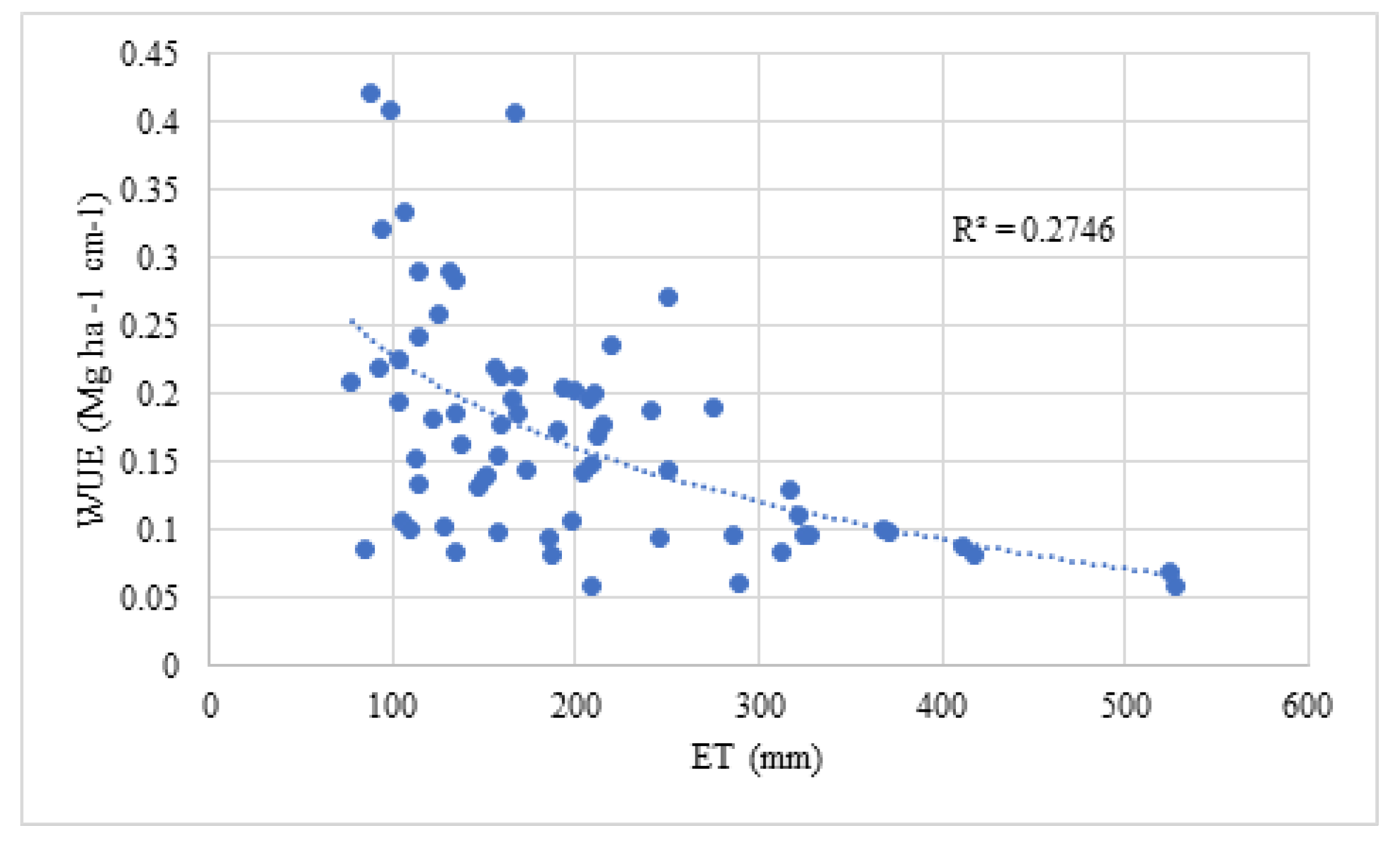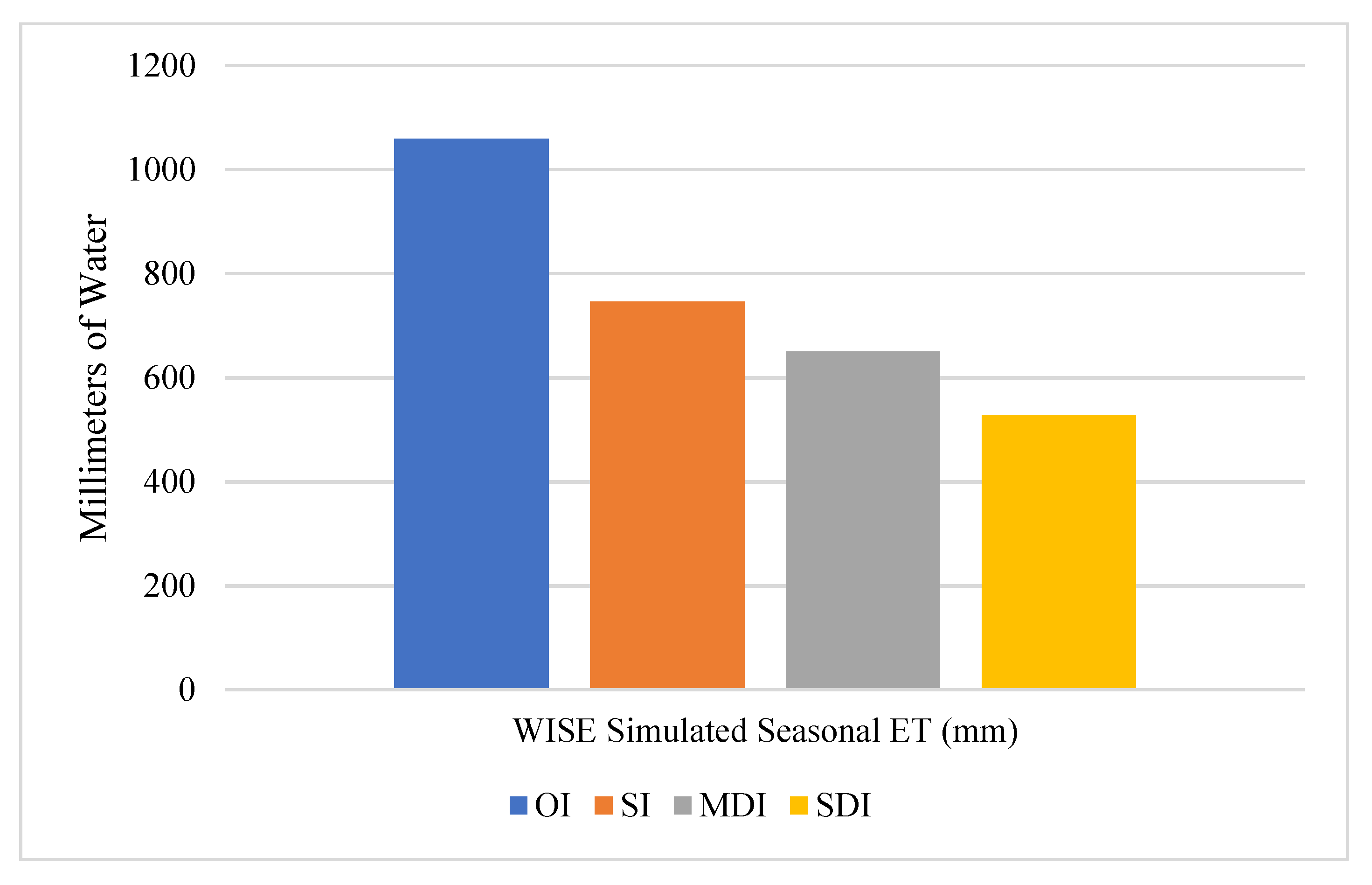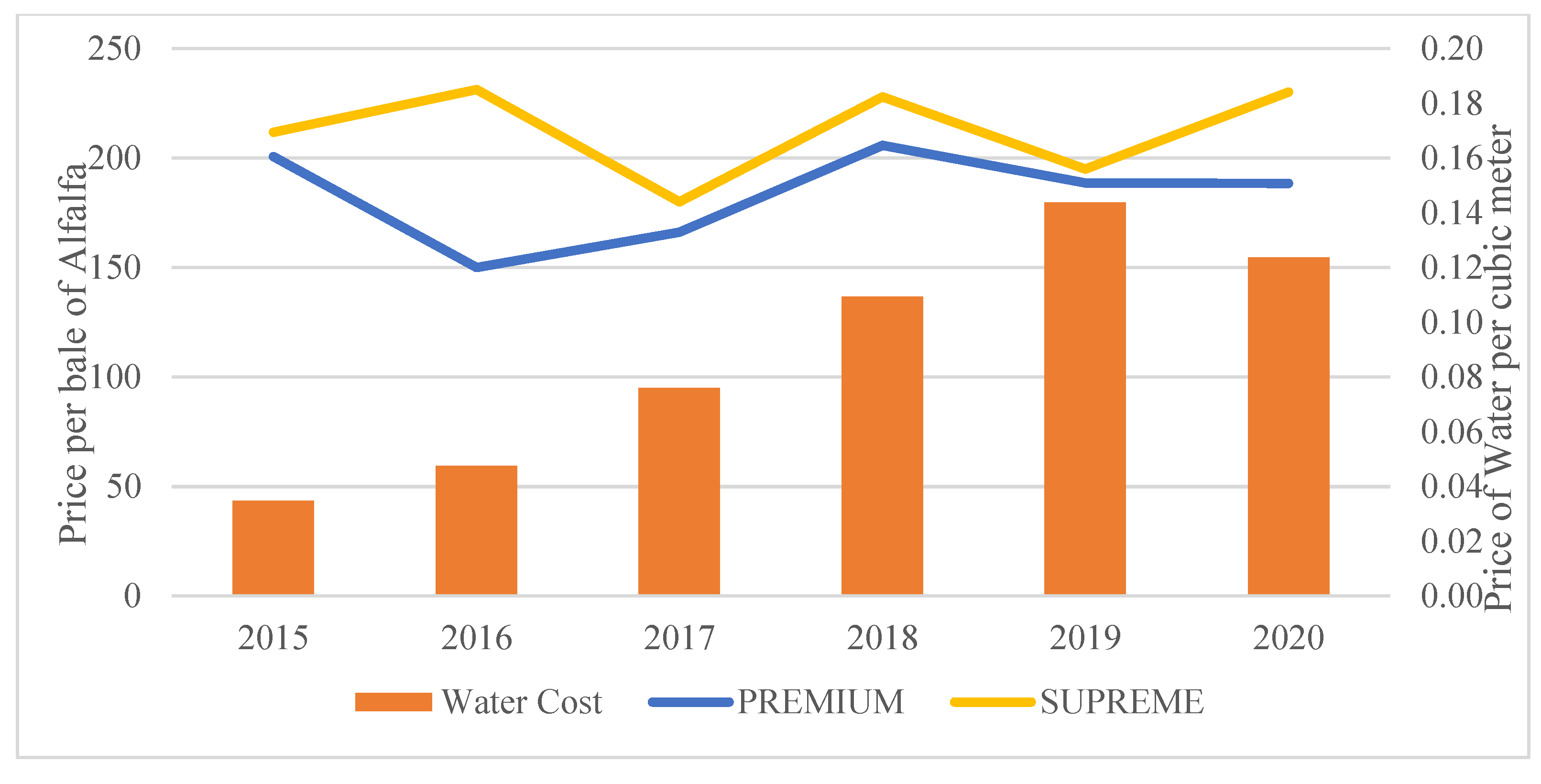Developing a Crop Water Production Function for Alfalfa under Deficit Irrigation: A Case Study in Eastern Colorado
Abstract
:1. Introduction
2. Materials and Methods
2.1. Observational Study Site
2.2. Measurements and Water Deficit Treatments
2.3. Alfalfa ET, Water Use Efficiency (WUE), and Market Value of Reduced CU
2.4. Statistical Analyses
3. Results
3.1. Deficit Irrigation
3.2. Alfalfa ET and Biomass
3.3. WUE
3.4. Effects of Deficit Irrigation on Alfalfa Biomass and RFV
3.5. Estimated CU Savings and Profits
4. Discussion
5. Conclusions
Author Contributions
Funding
Institutional Review Board Statement
Data Availability Statement
Acknowledgments
Conflicts of Interest
References
- USDA National Agricultural Statistics Service. Available online: www.nass.usda.gov (accessed on 17 October 2022).
- Schneekloth, J.; Andales, A.A. Seasonal Water Needs and Opportunities for Limited Irrigation for Colorado Crops. Colorado State University Extension. 2017. Available online: https://extension.colostate.edu/docs/pubs/crops/04718.pdf (accessed on 17 October 2022).
- Cao, X.; Feng, Y.; Li, H.; Zheng, H.; Wang, J.; Tong, C. Effects of Subsurface Drip Irrigation on Water Consumption and Yields of Alfalfa under Different Water and Fertilizer Conditions. J. Sens. 2021, 2021, 6617437. [Google Scholar] [CrossRef]
- Liu, M.; Wu, X.; Yang, H. Evapotranspiration characteristics and soil water balance of alfalfa grasslands under regulated deficit irrigation in the inland arid area of Midwestern China. Agric. Water Manag. 2022, 260, 107316. [Google Scholar] [CrossRef]
- Ali, M.H.; Hoque, M.R.; Hassan, A.A.; Khair, A. Effects of deficit irrigation on yield, water productivity, and economic returns of wheat. Agric. Water Manag. 2007, 92, 151–161. [Google Scholar] [CrossRef]
- Colorado Water Conservation Board. Colorado Water Plan; Colorado Water Conservation Board: Denver, CO, USA, 2015. [Google Scholar]
- Hawkes, K.; McClaran, M.P.; Brugger, J.; Crimmins, M.A.; Howery, L.D.; Ruyle, G.B.; Sprinkle, J.E.; Tolleson, D.R. Guide to Co-Developing Drought Preparation Plans for Livestock on Southwest National Forests. Coop. Ext. Bull., University of Arizona. 2018. Available online: http://m.gccga.com/assets/master_guidetocodevelopingdroughtprepplansforlivestockgrazingonswnationalforests_04oct2017.pdf (accessed on 17 January 2023).
- Glennon, R. Op-ed: To Fight the Drought, Cities Should Pay Farmers to Get Smarter About Irrigation. The Conversation 2022. Available online: https://civileats.com/2022/07/14/op-ed-fight-drought-cities-pay-farmers-smarter-irrigation/ (accessed on 17 January 2023).
- WestWater Research. Alternative Water Transfers in Colorado: A Review of ATMs for Front Range Municipalities. 2016. Available online: https://www.edf.org/sites/default/files/alternative-water-transfers-colorado.pdf (accessed on 17 October 2022).
- Colorado Water Plan Update. Available online: https://dnrweblink.state.co.us/CWCB/0/edoc/217373/ColoradoWaterPlanPublicReviewDraft.pdf (accessed on 17 January 2023).
- Watson, P.S.; Davies, S. Modeling the effects of population growth on water resources: A CGE analysis of the South Platte River Basin in Colorado. Ann. Reg. Sci. 2017, 46, 331–348. [Google Scholar] [CrossRef]
- Lamm, F.R.; Trooien, T.P. Subsurface drip irrigation for corn production: A review of 10 years of research in Kansas. Irrig. Sci. 2003, 22, 195–200. [Google Scholar] [CrossRef]
- Hanson, B.; Putnam, D. Can Alfalfa be Produced with Less Water? In Proceedings of the 30th California Alfalfa & 29th National Alfalfa Symposium, Las Vegas, NV, USA, 11–12 December 2000; pp. 43–54. [Google Scholar]
- Brown, P.W.; Tanner, C.B. Alfalfa Stem and Leaf Growth during Water Stress. Agron. J. 1983, 75, 799–805. [Google Scholar] [CrossRef]
- Sammis, T.W. Yield of Alfalfa and Cotton as Influenced by Irrigation. Agron. J. 1981, 73, 323–329. [Google Scholar] [CrossRef]
- Smeal, D.; Gregory, E.J.; Arnold, R.N. Interseasonal Variability in the Water Use-Production function of Alfalfa. J. Prod. Agric. 1992, 5, 576–580. [Google Scholar] [CrossRef]
- Varzi, M.; Trout, T.J.; DeJonge, K.C.; Oad, R. Optimal Water Allocation under Deficit Irrigation in the Context of Colorado Water Law. J. Irrig. Drain. Eng. 2019, 145, 05019003. [Google Scholar] [CrossRef]
- Toba, T.; Ohta, T. An observational study of the factors that influence interception loss in boreal and temperate forests. J. Hydrol. 2005, 313, 208–220. [Google Scholar] [CrossRef]
- Colorado State University. CoAgMet Crop ET Access. Colorado Agricultural Meteorological Network. Available online: https://coagmet.colostate.edu/ (accessed on 17 January 2023).
- Dane, J.H.; Topp, G.C.; Campbell, G.S. Methods of soil analysis; Part 4; Soil Science Society of America: Madison, WI, USA, 2002; Available online: https://dl.sciencesocieties.org/publications/books/tocs/sssabookseries/methodsofsoilan4 (accessed on 17 August 2022)ISBN 978-0-89118-893-3.
- Ward, R.; de Ondarza, M.B. Relative Feed Value (RFV) vs. Relative Forage Quality (RFQ). 14 February 2008. Available online: https://www.foragelab.com/Media/RFV_vs_RFQ-CVAS%20Perspective.pdf (accessed on 13 September 2022).
- Marten, G.C.; Shenk, J.S.; Barton, F.E., II. Near Infrared Reflectance Spectroscopy (NIRS): Analysis of Forage Quality; Marten, G.C., Shenk, J.S., Barton, F.E., II, Eds.; United States Department of Agriculture: Washington, DC, USA, 1989. [Google Scholar]
- Allen, R.G.; Pereira, L.S.; Raes, D.; Smith, M. Crop Evapotranspiration: Guidelines for Computing Crop Water Requirements—FAO Irrigation and drainage; Allen, R.G., Ed.; Food and Agriculture Organization of the United Nations: Rome, Italy, 1998; ISBN 978-92-5-104219-9. [Google Scholar]
- USDA-NRCS. “Hydrologic Soil-cover Complexes,” in Hydrology National Engineering Handbook. In Part 630; 2004. Available online: https://directives.sc.egov.usda.gov/OpenNonWebContent.aspx?content=17758.wba (accessed on 20 October 2022).
- Orloff, S.B.; Putnam, D. Drought Tip: Drought Strategies for Alfalfa; University of California Agriculture and Natural Resources: Davis, CA, USA, 2015. [Google Scholar]
- Northern Colorado Water Conservancy District. Past Regional Pool Bid Tables. Available online: https://www.northernwater.org/your-water/regional-pool (accessed on 17 October 2022).
- Virtanen, P.; Gommers, R.; Oliphant, T.E.; Haberland, M.; Reddy, T.; Cournapeau, D.; Burovski, E.; Peterson, P.; Weckesser, W.; Bright, J. SciPy 10: Fundamental Algorithms for Scientific Computing in Python. Nat. Methods 2020, 17, 261–272. [Google Scholar] [CrossRef] [PubMed] [Green Version]
- Lindenmayer, R.B.; Hansen, N.C.; Brummer, J.; Pritchett, J.G. Deficit Irrigation of Alfalfa for Water-Savings in the Great Plains and Intermountain West: A Review and Analysis of the Literature. Agron. J. 2011, 103, 45–50. [Google Scholar] [CrossRef]
- French, R.; Schultz, J. Water use efficiency of wheat in a Mediterranean-type environment. II. some limitations to efficiency. Aust. J. Agric. Res. 1984, 35, 765. [Google Scholar] [CrossRef]
- Shewmaker, G.E.; Allen, R.G.; Neibling, W.H. Alfalfa Irrigation and Drought; University of Idaho College of Agricultural and Life Sciences: Moscow, ID, USA, 2013. [Google Scholar]
- Andales, A.A.; Bauder, T.A.; Arabi, M. A Mobile Irrigation Water Management System Using a Collaborative GIS and Weather Station Networks. In Advances in Agricultural Systems Modeling; Ahuja, L.R., Ma, L., Lascano, R.J., Eds.; American Society of Agronomy and Soil Science Society of America: Madison, WI, USA, 2014; pp. 53–84. ISBN 978-0-89118-344-0. [Google Scholar]
- Andales, A.A.; Bartlett, A.C.; Bauder, T.A.; Wardle, E.M. Adapting a Cloud-Based Irrigation Scheduler for Sugar Beets in the High Plains. Appl. Eng. Agric. 2020, 36, 479–488. [Google Scholar] [CrossRef]
- Bauder, J.W.; Bauer, A.; Ramirez, J.M.; Cassel, D.K. Alfalfa Water Use and Production on Dryland and Irrigated Sandy Loam. Agron. J. 1978, 70, 95–99. [Google Scholar] [CrossRef]
- Ismail, S.M.; Almarshadi, M.H. Maximizing productivity and water use efficiency of alfalfa under precise subsurface drip irrigation in arid regions: On-farm irrigation management. Irrig. Drain. 2013, 62, 57–66. [Google Scholar] [CrossRef]
- Lamm, F.R.; Harmoney, K.R.; Aboukheira, A.A.; Johnson, S.K. Alfalfa Production with Subsurface Drip Irrigation in the Central Great Plains. ASABE 2012, 55, 1203–1212. [Google Scholar] [CrossRef]
- Loomis, R.S.; Wallinga, J. Alfalfa: Efficient or Inefficient User of Water. In Proceedings of the 21st California Alfalfa Symposium, Sacramento, CA, USA, 9–10 December 1991. [Google Scholar]
- Asseng, S.; Hsiao, T.C. Canopy CO2 assimilation, energy balance, and water use efficiency of an alfalfa crop before and after cutting. Field Crops Res. 2000, 67, 191–206. [Google Scholar] [CrossRef]
- Hanson, A.A. Alfalfa and Alfalfa Improvement; American Society of Agronomy: Madison, WI, USA, 1988; ISBN 978-0-89118-094-4. [Google Scholar]
- Hanson, B.; Putnam, D.; Snyder, R. Deficit irrigation of alfalfa as a strategy for providing water for water-short areas. Agric. Water Manag. 2007, 93, 73–80. [Google Scholar] [CrossRef]
- Orloff, S.B.; Carlson, H.L.; Teuber, L.R. Intermountain Alfalfa Management; University of California, Division of Agriculture and Natural Resources: Oakland, CA, USA, 1997; ISBN 978-1-879906-24-2. [Google Scholar]
- Li, Z.; Li, X.; He, F. Drip Irrigation Depth Alters Root Morphology and Architecture and Cold Resistance of Alfalfa. Agronomy 2022, 12, 2192. [Google Scholar] [CrossRef]
- Zhang, X.; Pei, D.; Chen, S. Root growth and soil water utilization of winter wheat in the North China Plain. Hydrol. Process. 2004, 18, 2275–2287. [Google Scholar] [CrossRef]
- Mooney, D. More Risk, More Money: When are Payments for Water Savings from Limited Irrigation Profitable for Farmers? Water Resour. Econ. 2022, 40, 100212. [Google Scholar] [CrossRef]
- Yost, M.; Allen, N.; Kitchen, B.; Creech, E. Strategies for Deficit Irrigation of Forage Crops. Available online: https://extension.usu.edu/crops/research/strategies-for-deficit-irrigation-of-forage-crops (accessed on 20 September 2022).
- Carter, P.R.; Sheaffer, C.C. Alfalfa Response to Soil Water Deficits. I. Growth, Forage Quality, Yield, Water Use, and Water-Use Efficiency. Crop Sci. 1983, 23, 669–675. [Google Scholar] [CrossRef]
- Kamran, M.; Yan, Z.; Jia, Q.; Chang, S.; Ahmad, I.; Ghani, M.U.; Hou, F. Irrigation and nitrogen fertilization influence on alfalfa yield, nutritive value, and resource use efficiency in an arid environment. Field Crops Res. 2022, 284, 108587. [Google Scholar] [CrossRef]
- Irmak, S.; Hay, D.; Anderson, B.; Kranz, W.; Yonts, C.D. Irrigation Management and Crop Characteristics of Alfalfa; University of Nebraska-Lincoln Extension, Institute of Agriculture and Natural Resources: Lincoln, NE, USA, 2007; Available online: https://extensionpublications.unl.edu/assets/pdf/g1778.pdf (accessed on 17 January 2023).
- Sanden, B.; Putnam, D.; Hanson, B. Forage Production Strategies with Limited Water Supplies. In Proceedings of the 37th California Alfalfa and Forage Symposium, San Diego, CA, USA, 17–19 December 2007; Available online: https://alfalfa.ucdavis.edu/+symposium/proceedings/2007/07-20.pdf (accessed on 17 January 2023).









| Month | Average Temperature (°C) | Average Precipitation (mm) | Average Solar Radiation (W m−2) | Average Wind Speed (m s−1) | Average Relative Humidity (%) | Average ETr * (mm) |
|---|---|---|---|---|---|---|
| January | −3.45 | 3.07 | 86.78 | 7.76 | 65.26 | 53.80 |
| February | −4.21 | 2.30 | 119.87 | 8.06 | 63.60 | 59.63 |
| March | 3.52 | 24.67 | 151.57 | 8.91 | 61.67 | 108.90 |
| April | 7.82 | 11.67 | 200.64 | 11.18 | 50.48 | 171.77 |
| May | 13.95 | 43.30 | 214.29 | 10.48 | 60.09 | 197.77 |
| June | 21.39 | 18.46 | 257.03 | 9.75 | 53.28 | 249.96 |
| July | 23.77 | 26.00 | 250.61 | 9.24 | 56.26 | 248.13 |
| August | 22.46 | 12.40 | 229.86 | 7.61 | 55.25 | 215.85 |
| September | 17.03 | 7.10 | 192.20 | 7.57 | 53.75 | 166.45 |
| October | 8.38 | 4.00 | 141.13 | 7.82 | 53.97 | 129.95 |
| November | 3.63 | 2.40 | 101.31 | 7.06 | 55.14 | 83.00 |
| December | −2.15 | 2.15 | 83.89 | 8.12 | 55.66 | 70.40 |
| Soil Type | Field Capacity of 150 cm Rooting Zone (cm of Water) | Soil Layer Depth (cm) | Bulk Density (g cm−3) |
|---|---|---|---|
| Nunn clay loam | 48.42 | 0–30 | 1.08 |
| 30–60 | 1.46 | ||
| 60–90 | 1.39 | ||
| 90–120 | 1.46 | ||
| 120–150 | 1.75 | ||
| Colombo clay loam | 40.37 | 0–30 | 1.06 |
| 30–60 | 1.50 | ||
| 60–90 | 1.39 | ||
| 90–120 | 1.53 | ||
| 120–150 | 1.46 |
| Levels of Irrigation a | Zones |
|---|---|
| Over Irrigation (OI) | 7 and 16 |
| Standard Irrigation (SI) | 9 and 10 |
| Moderate Deficit Irrigation (MDI) | 8 and 19 |
| Severe Deficit Irrigation (SDI) | 17 and 18 |
| Year | Precipitation (mm) | Treatment a | Irrigation (mm) | ETc (mm) |
|---|---|---|---|---|
| 2022 | 117 | OI | 359 | 559 |
| SI | 354 | 638 | ||
| MDI | 265 | 495 | ||
| SDI | 232 | 391 | ||
| 2021 | 138 | OI | 300 | 374 |
| SI | 269 | 345 | ||
| MDI | 146 | 240 | ||
| SDI | 112 | 298 | ||
| 2020 | 106 | OI | 617 | 502 |
| SI | 520 | 558 | ||
| MDI | 340 | 412 | ||
| SDI | 240 | 279 | ||
| 2019 | 223 | OI | 545 | 826 |
| SI | 470 | 826 | ||
| MDI | 329 | 873 | ||
| SDI | 216 | 700 | ||
| 2018 | 165 | SI | 516 | 743 |
| MDI | 406 | 668 | ||
| SDI | 335 | 562 |
| Zone | 2018–2019 | 2019–2020 | 2020–2021 | 2021–2022 |
|---|---|---|---|---|
| 7 | 14.74% | 8.00% | −17.26% | −10.78% |
| 8 | 19.87% | −16.28% | −11.76% | 38.34% |
| 9 | 31.06% | −13.28% | −3.33% | −7.09% |
| 10 | 20.44% | 10.75% | −16.82% | −18.44% |
| 16 | −37.36% | −5.74% | −8.90% | 34.68% |
| 17 | 59.25% | −50.48% | −47.04% | 62.70% |
| 18 | 47.23% | −28.41% | −63.54% | 63.45% |
| 19 | 3.89% | −0.17% | −13.20% | 58.19% |
| Irrigation Level | WUE(Mg ha−1 cm−1) |
| Over Irrigation (OI) | 0.162 |
| Standard Irrigation (SI) | 0.183 |
| Moderate Deficit Irrigation (MDI) | 0.165 |
| Severe Deficit Irrigation (SDI) | 0.171 |
| Water Price, $ m−3 | |||||||
|---|---|---|---|---|---|---|---|
| Irrigation Level | Yield Bales ha−1 | CU Saved m3 ha−1 | 0.12 | 0.24 | 0.36 | 0.48 | 0.60 |
| OI | 22.10 | - | - | - | - | - | - |
| SI | 15.83 | 3133.6 | −$1066 | −$690 | −$314 | $62 | $438 |
| MDI | 13.25 | 4097.4 | −$1544 | −$1052 | −$560 | −$69 | $423 |
| SDI | 11.41 | 5310.1 | −$1821 | −$1184 | −$547 | $90 | $727 |
Disclaimer/Publisher’s Note: The statements, opinions and data contained in all publications are solely those of the individual author(s) and contributor(s) and not of MDPI and/or the editor(s). MDPI and/or the editor(s) disclaim responsibility for any injury to people or property resulting from any ideas, methods, instructions or products referred to in the content. |
© 2023 by the authors. Licensee MDPI, Basel, Switzerland. This article is an open access article distributed under the terms and conditions of the Creative Commons Attribution (CC BY) license (https://creativecommons.org/licenses/by/4.0/).
Share and Cite
Sitterson, J.M.; Andales, A.A.; Mooney, D.F.; Capurro, M.C.; Brummer, J.E. Developing a Crop Water Production Function for Alfalfa under Deficit Irrigation: A Case Study in Eastern Colorado. Agriculture 2023, 13, 831. https://doi.org/10.3390/agriculture13040831
Sitterson JM, Andales AA, Mooney DF, Capurro MC, Brummer JE. Developing a Crop Water Production Function for Alfalfa under Deficit Irrigation: A Case Study in Eastern Colorado. Agriculture. 2023; 13(4):831. https://doi.org/10.3390/agriculture13040831
Chicago/Turabian StyleSitterson, Jan M., Allan A. Andales, Daniel F. Mooney, Maria Cristina Capurro, and Joe E. Brummer. 2023. "Developing a Crop Water Production Function for Alfalfa under Deficit Irrigation: A Case Study in Eastern Colorado" Agriculture 13, no. 4: 831. https://doi.org/10.3390/agriculture13040831





